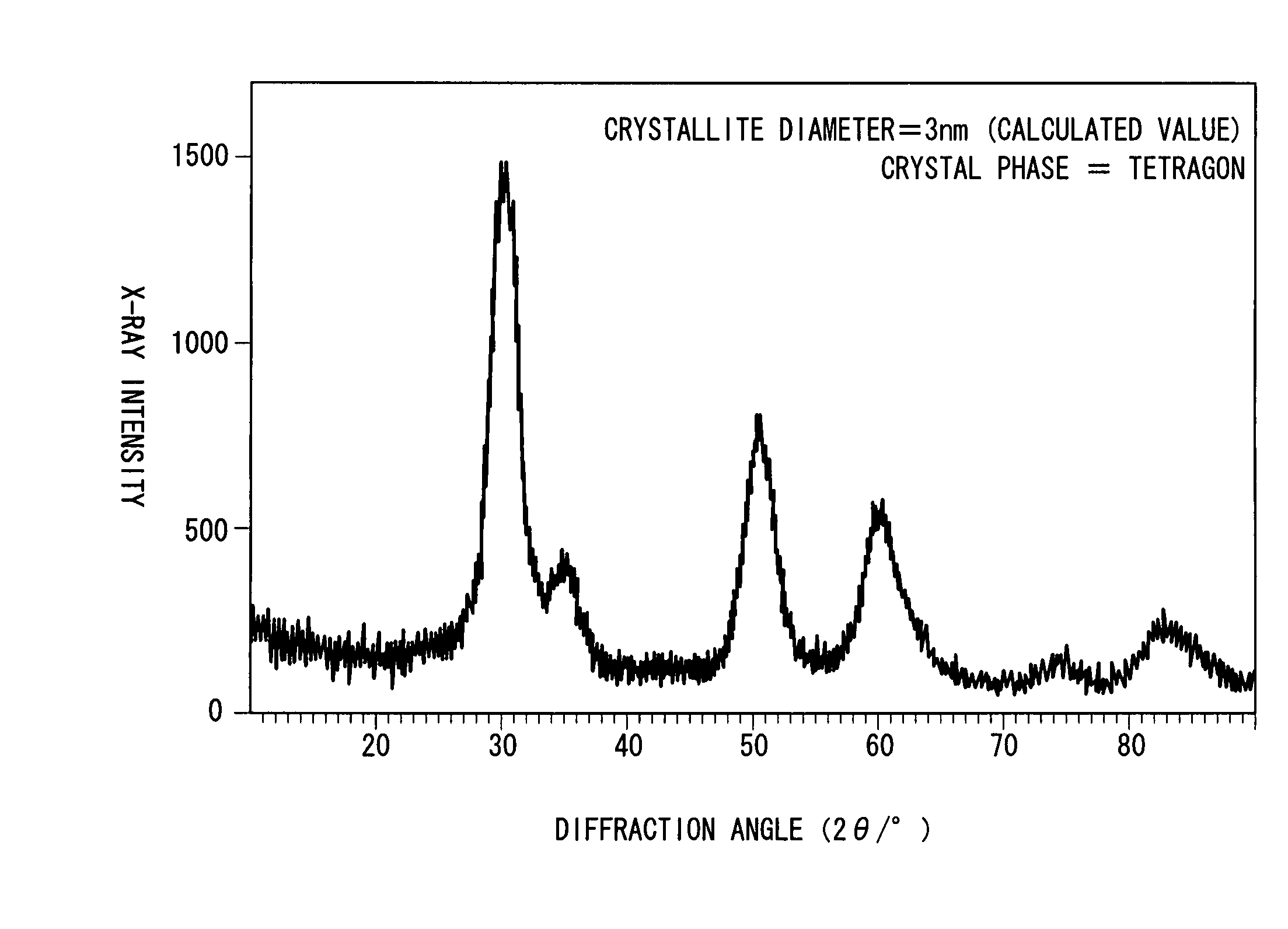Transparent zirconia dispersion and zirconia particle-containing resin composition, composition for sealing light emitting element and light emitting element, hard coat film and optical functional film and optical component, and method for producing zirconia particle-containing resin
a technology applied in the field of transparent inorganic oxide dispersion, can solve the problems of difficult separation of inorganic oxide particles and resins, and difficult to maintain transparency, so as to achieve high refractive index and improve mechanical properties. the effect of high transparency
- Summary
- Abstract
- Description
- Claims
- Application Information
AI Technical Summary
Benefits of technology
Problems solved by technology
Method used
Image
Examples
example 1
[0247]To a zirconium salt solution containing 2,615 g of zirconium oxychloride octahydrate dissolved in pure 40 L (liter) of water, diluted ammonia water containing 344 g of 28% ammonia water in 20 L of pure water was added while stirring to prepare a zirconia precursor slurry.
[0248]To the slurry, a sodium sulfate aqueous solution containing 300 g of sodium sulfate in 5 L of pure water was added while stirring. The amount of sodium sulfate was 30% by weight based on zirconia ions as zirconia in the zirconium salt solution.
[0249]The mixture was dried in atmospheric air at 130° C. for 24 hours using a dryer to obtain a solid matter.
[0250]The solid matter was ground by an automatic mortar and then calcined in atmospheric air at 500° C. for one hour using an electric furnace.
[0251]The calcined material was put in pure water and stirred to form a slurry, which was washed using a centrifuge. After sodium sulfate added was sufficiently removed, the residue was dried by a dryer to produce z...
example 2
[0259]In the same manner as in Example 1, zirconia particles were synthesized to produce zirconia particles.
[0260]To 10 g of the zirconia particles, 85 g of toluene as a disperse medium and 5 g of a methoxy modified silicone KR-213 (manufactured by Shin-Etsu Chemical Co., Ltd.) as a surface modifier were added, followed by mixing and a dispersion treatment to prepare a transparent inorganic oxide dispersion (Z2) of Example 2.
[0261]In the same manner as in Example 1, the disperse particle diameter and the visible light transmittance of zirconia particles were measured. The measurement results are shown in Table 2.
example 3
[0272]To 100 g of the transparent inorganic oxide dispersion (Z1) of Example 1, 10 g of silicone oil (mixture of methylhydrodienepolysiloxane and organopolysiloxane having a vinyl group at both ends) was added and also chloroplatinic acid was added in an amount of 20 ppm based on 100 parts by weight of silicone oil, followed by removal of the solvent through vacuum drying to prepare a resin composition.
[0273]The resin composition was poured into a mold assembled using a glass plate in a thickness of 1 mm and then cured by heating at 150° C. for 2 hours to prepare an inorganic oxide particle-containing resin composition of Example 3.
[0274]The content of zirconia of the inorganic oxide particle-containing resin composition was 50% by weight.
PUM
| Property | Measurement | Unit |
|---|---|---|
| particle diameter | aaaaa | aaaaa |
| particle diameter | aaaaa | aaaaa |
| visible light transmittance | aaaaa | aaaaa |
Abstract
Description
Claims
Application Information
 Login to View More
Login to View More - R&D
- Intellectual Property
- Life Sciences
- Materials
- Tech Scout
- Unparalleled Data Quality
- Higher Quality Content
- 60% Fewer Hallucinations
Browse by: Latest US Patents, China's latest patents, Technical Efficacy Thesaurus, Application Domain, Technology Topic, Popular Technical Reports.
© 2025 PatSnap. All rights reserved.Legal|Privacy policy|Modern Slavery Act Transparency Statement|Sitemap|About US| Contact US: help@patsnap.com



